
Dim sum is a large range of small Cantonese dishes that are traditionally enjoyed in restaurants for brunch. Most modern dim sum dishes are commonly associated with Cantonese cuisine, although dim sum dishes also exist in other Chinese cuisines. In the tenth century, when the city of Canton (Guangzhou) began to experience an increase in commercial travel, many frequented teahouses for small-portion meals with tea called "yum cha" (brunch). "Yum cha" includes two related concepts. The first is "jat zung loeng gin", which translates literally as "one cup, two pieces". This refers to the custom of serving teahouse customers two delicately made food items, savory or sweet, to complement their tea. The second is dim sum, which translates literally to "touch the heart", the term used to designate the small food items that accompanied the tea.
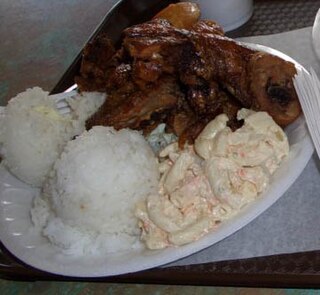
The plate lunch is a quintessentially Hawaiian meal, roughly analogous to Southern U.S. meat-and-threes. However, the combination of American and pan-Asian influence makes the plate lunch unique to Hawaii.

The cuisine of Hawaii incorporates five distinct styles of food, reflecting the diverse food history of settlement and immigration in the Hawaiian Islands.
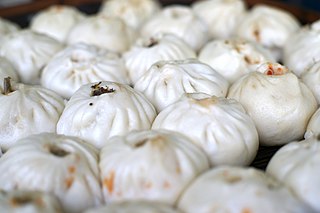
Baozi, or simply bao, is a type of yeast-leavened filled bun in various Chinese cuisines. There are many variations in fillings and preparations, though the buns are most often steamed. They are a variation of mantou from Northern China.

Char siu is a Cantonese–style of barbecued pork. Originating in Guangdong, it is eaten with rice, used as an ingredient for noodle dishes or in stir fries, and as a filling for chasiu baau or pineapple buns. Five-spice powder is the primary spice, honey or other sweeteners are used as a glaze, and the characteristic red color comes from the red yeast rice when made traditionally.

Char siu bao is a Cantonese baozi (bun) filled with barbecue-flavored cha siu pork. They are served as a type of dim sum during yum cha and are sometimes sold in Chinese bakeries.

Siopao, is a Philippine steamed bun with various fillings. It is the indigenized version of the Fujianese baozi, introduced to the Philippines by Hokkien immigrants during the Spanish colonial period. It is a popular snack in the Philippines and is commonly sold by bakeries and restaurants.

A rice noodle roll, also known as a steamed rice roll and cheung fun, and as look funn or look fun in Hawaii, is a Cantonese dish originating from Guangdong Province in southern China, commonly served as either a snack, small meal or variety of dim sum. It is a thin roll made from a wide strip of shahe fen, filled with shrimp, beef, vegetables, or other ingredients. Seasoned soy sauce – sometimes with siu mei drippings – is poured over the dish upon serving. When plain and made without filling, the rice noodle is also known as jyu cheung fun, literally "pork intestine noodle", a reference to its resemblance of a pig's intestines. There is no official recording of the history of rice noodle rolls; most cookbooks claim that it was first made in the 1930s. In Guangzhou, Guangdong Province, people called the dish laai cheung because it is a noodle roll that pulled by hand.

Japanese Chinese cuisine, also known as Chūka, represents a unique fusion of Japanese and Chinese culinary traditions that have evolved over the late 19th century and more recent times. This style, served predominantly by Chinese restaurants in Japan, stands distinct from the "authentic Chinese food" found in areas such as Yokohama Chinatown. Despite this difference, the cuisine retains strong influences from various Chinese culinary styles, as seen in the Shippoku cooking style.

Shumai is a type of traditional Chinese dumpling. In Cantonese cuisine, it is usually served as a dim sum snack. In addition to accompanying the Chinese diaspora, a variation of shumai also appears in Japan as and various southeast Asian countries.

Shengjian mantou, shengjian bao, or shengjian for short, is a type of small, pan-fried baozi which is a specialty of Suzhou and Shanghai. It is typically filled with pork and gelatin that melts into soup/liquid when cooked. Within Shanghai, shengjian mantou typically have thin, crispy skins while those sold elsewhere usually have thicker, bread-like skins. It first originated and became popular in Suzhou at the beginning of the 20th century. Then, its popularity spread to the Yangtze River Delta. It has been one of the most common breakfast items in Shanghai since the early 1920s. As a ubiquitous breakfast item, it has a significant place in Shanghai cuisine.
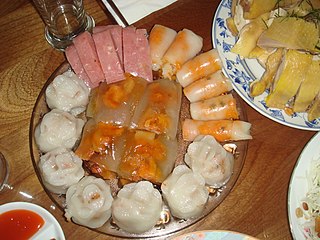
In Vietnamese, the term bánh translates loosely as "cake" or "bread", but refers to a wide variety of prepared foods that can easily be eaten by hands or chopsticks. With the addition of qualifying adjectives, bánh refers to a wide variety of sweet or savory, distinct cakes, buns, pastries, sandwiches, and other food items, which may be cooked by steaming, baking, frying, deep-frying, or boiling. Foods made from wheat flour or rice flour are generally called bánh, but the term may also refer to certain varieties of noodle and fish cake dishes, such as bánh canh and bánh hỏi.
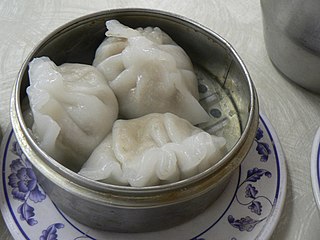
Fun guo, or Chaozhou fun guo (潮州粉粿), sometimes spelled fun quor, fun gor, fen guo, Chiu Chow dumpling, Teochew dumpling, or fun kor, is a variety of steamed dumpling from the Chaoshan area of coastal eastern Guangdong, a province in Southern China. Fun guo looks very similar to har gaw in Cantonese-style dim sum.
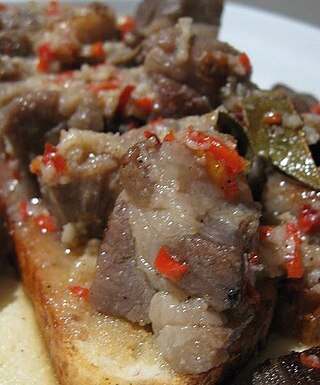
Carne de vinha d'alhos is a Portuguese dish categorized according to the mode of preparation via a marinade. The name means "meat of wine with garlic". Originating in Madeira and the Azores islands, it is typically made with salt, paprika, red pepper paste and wine or vinegar as well as garlic. It is traditionally served at Christmas time in Madeira.

Xiaochi is an important category of Chinese street food, commonly found in Chinese populated communities around the world. Xiaochi are substantial snacks, which can be eaten together or with more substantial dishes like the Spanish tapas or Middle Eastern Levantine meze, or alone as a light meal or snack like the French goûter.

HK Cafe is a Chinese restaurant in Portland, Oregon.



















